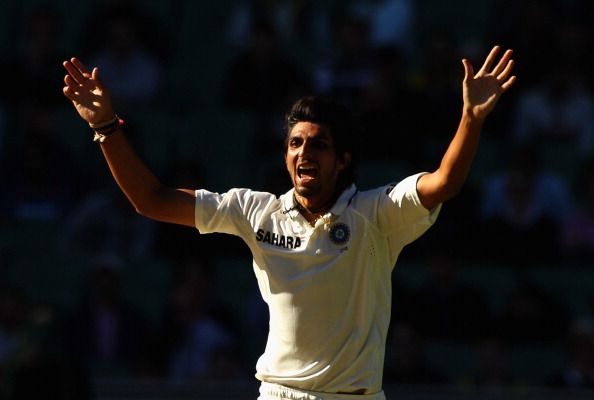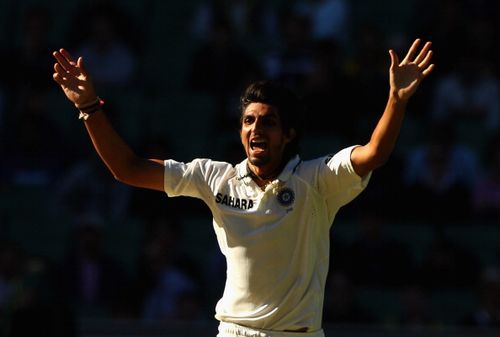
The curious case of Ishant Sharma: decoding the stats

There is one thing I am quite certain of as I start on this article – Ishant Sharma, on his day, can be an excellent Test bowler; the challenge, for his captain, currently MS Dhoni, is to accurately identify that particular day. Before the knives are out for me for bracketing Ishant as ‘excellent’, and some statistician tells me that he is fighting it out with Fidel Edwards for the worst bowling average among current specialist bowlers with at least 50 Tests to their name, I would like to forward this analysis on Ishant, attempting to present a case for him by diving deeper into the very parameter which is currently his scourge – bowling average.
Flashes of brilliance
Ishant made his debut against Bangladesh in 2007 after an injury to Munaf Patel ruled the Ikhar-born bowler out. But Ishant shot into prominence during the Australia vs India 2007-08 Test series in Australia, particularly in the 3rd Test at Perth, where he practically toyed with Aussie captain Ricky Ponting, beating him regularly with quick, controlled seam bowling, before finally taking his wicket. This was the second instance of a youngster demolishing a superstar in the sporting arena in January 2008, the other being the absolute demolition of Rafael Nadal by a relatively unknown Jo Wilfred Tsonga, in straight sets at the 2008 Australian Open semi-finals.
Besides my soft corner for the game of tennis, the reason for drawing a comparison to another player is the relative similarity in their careers – Tsonga, who on his day can beat anyone, is yet to win a Grand Slam; he had one of his days, or I should say weeks, during the Rogers Cup last week, where he beat four top-10 players including Roger Federer in the final to clinch the cup. Ishant has run through oppositions several times, the most recent being the second innings at Lord’s, while looking utterly pedestrian on other occasions.

Getting back to his bowling average, Ishant, at the end of the Lord’s Test during the Investec Series against England in 2014, averaged 37.04 after 57 Test matches and 103 innings (of which he did not bowl in 3), which is not good by any stretch of imagination. As part of the analysis, I have broken down this average into smaller segments, in a bid to identify the number of innings where he performed excellently, was average, and instances where he was downright pathetic.
A mediocre record
A consistently mediocre bowler is expected to hover in the range of 30-40 in terms of average, and I expected a majority of Ishant’s innings’ averages to be in this zone. However, as the graphic alongside indicates, this segment accounts for only 8 out of his completed 100 innings. The first slice of the pie came as the biggest surprise, with the graphic indicating that the 25-year-old has had a bowling average of 20 & lower in 29 innings, and 25 & lower in 37 innings, figures which are almost Steyn-esque in nature.
In that case, what is bloating the average? The answer is equally surprising, or a better word in this case, shocking – 13 innings with a bowling average between 60-100, and even 3 instances of innings with bowling average in excess if 100. If we combine this with innings of No Average (NA), i.e. when he went wicketless and gave away runs in excess of 50, then we have a total of 31 downright pathetic innings; in a nutshell, Ishant operates in extremes – when he is good, he is usually excellent, and when is bad, he is usually terrible.
So, what does this analysis tell us about Ishant? Not much, except for the fact that he is an enigma, who cannot be bracketed as mediocre, given the number of times he has single-handedly turned Test matches in India’s favor, when in rhythm. This brings up the more interesting questions – should he be persisted with? If so, how to deal with his stark inconsistency? The first answer, based on a healthy cocktail of empirical/statistical evidence, and the lack of quality replacements, is a resounding YES.
To answer the second, I will enter the realm of speculation, backed by observational data. Ishant Sharma is very much a rhythm bowler, and he usually performs better when he gets early wickets. I remember that in the Durban Test in late 2013, Dale Steyn went wicketless for more than 100 runs against India, but came back to take 6 wickets in a fiery spell to win the game for South Africa. I do not recall such instances in Ishant’s case; if he goes wicketless for the first 50-60 runs, and is struggling rhythm-wise, the probability of him suddenly snapping into form is low. This is where the captain has to identify if it is Ishant-the-excellent or Ishant-the-pathetic who has turned up on that particular day.
How MS Dhoni could help Ishant
From his wicketkeeping position, Dhoni is in an excellent position to understand the rhythm Ishant is in, and if he is struggling, it would be a mistake to make him keep trudging in, with the hope of a wicket somewhere, because, given his track record, that is highly unlikely. A better option would be to use him in short bursts of 3-4 overs, rather than keep him on continuously at one end. This ploy may still not get India wickets, but it would keep Ishant relatively fresh, and might contain him in the ‘mediocre’ zone without crossing over into the ‘pathetic’ zone.
The solution may be easier to preach than to practise, given that India usually bowls with one less specialist bowler, requiring more of the workload to be shared among the four specialist bowlers. However, there is no denying the fact that Ishant needs to be preserved, and persevered with, given that when on song, he brings to the table a combination of height, speed and skill which is a rarity among Indian fast bowlers.
The performances in the ‘excellent’ zone will keep coming; the challenge will be to push as many performances in the ‘pathetic’ zone as possible to the ‘mediocre’ zone. If handled correctly, Ishant, who is still below 26 after more than 7 years of international cricket experience, will be a force to reckon with, for several years to come.